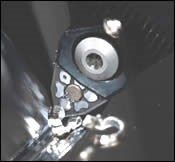Atomic-Level Engineering For Greater Tool Life
Manipulating the direction of aluminum oxide crystals produces a cutting tool coating that is harder, and also cuts cooler.
Share





Thickness, purity, structural integrity, smoothness and chemical composition are among the variables that cutting tool developers can manipulate to engineer and improve cutting tool coatings.
Don Graham, turning products manager with Seco Tools, says that now there is a new variable: crystal orientation.
Certain coatings have anisotropic properties, he says. Similar to the way wood behaves differently depending on whether force is applied along or against its grain, the microscopic crystals of a cutting tool coating can have different properties along different directions. Seco has developed a new process for controlling this direction.
One result is the company’s new “Duratomic” coating. Manipulating individual aluminum oxide crystals—in a sense, manipulating the material at the atomic level—has produced a coating that is more effective at machining a broad range of ferrous materials than any of the company’s previously available aluminum oxide coatings. The hardness of the previous coating tops out around 27 gigapascals (GPa), but the new coating reaches 30 GPa simply by taking advantage of the crystal’s inherently hardest direction. The company’s TP2500 grade of inserts mates this coating to a substrate designed to cover a similarly broad application range. The result is extended tool life across cast iron and various steels, including stainless—potentially allowing a job shop that faces this range of materials to reduce its insert inventory.
Mr. Graham says the improved tool life comes from more than just hardness. Interrupted cutting tests have shown that the coating offers clearly more toughness as well. The new coating also cuts cooler—an effect that was not quite so predictable.
When the new coating replaces a previous aluminum oxide coating, the same cut in 4140 steel that would have run at 915°C can be shown to run at 880°C. Both of those temperatures may seem very hot. However, Mr. Graham points out that abrasion wear resistance is temperature-dependent, and the severity of cratering is significantly affected by temperature variations specifically within this range. Cutting 35° cooler makes the tool’s resistance to both of these wear mechanisms that much higher, further extending life.
The reasons for this cooler-cutting effect are not yet well understood, says Mr. Graham. Controlling crystal orientation does not necessarily improve the smoothness of the surface, but making this change nevertheless seems to produce a tool that cuts as if the surface was smoother.
Related Content
-
High-Feed Machining Dominates Cutting Tool Event
At its New Product Rollout, Ingersoll showcased a number of options for high-feed machining, demonstrating the strategy’s growing footprint in the industry.
-
Toolpath Improves Chip Management for Swiss-Type Lathes
This simple change to a Swiss-type turning machine’s toolpath can dramatically improve its ability to manage chips.
-
The Future of High Feed Milling in Modern Manufacturing
Achieve higher metal removal rates and enhanced predictability with ISCAR’s advanced high-feed milling tools — optimized for today’s competitive global market.



















.png;maxWidth=300;quality=90)






